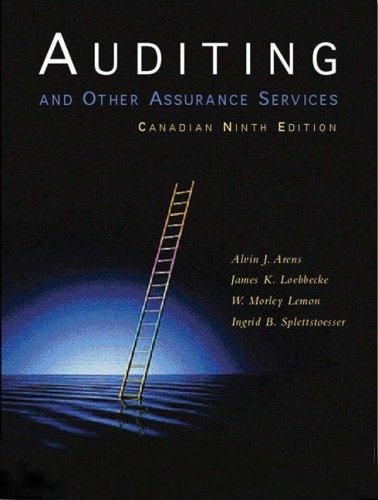The following questions concern materiality, risk, or evidence. Choose the best response. a. Edison Corporation has a
Question:
The following questions concern materiality, risk, or evidence. Choose the best response.
a. Edison Corporation has a few large accounts receivable that total $1,400,000. Victor Corporation has a great num¬ ber of small accounts receivable that also total $1,400,000. The importance of a misstatement in any one account is, therefore, greater for Edison than for Victor. This is an example of the auditor's concept of
(1) materiality.
(2) comparative analysis.
(3) reasonable assurance.
(4) relative risk.
b. Which of the following elements ultimately determines the specific auditing procedures that are necessary in the circumstances to afford a reasonable basis for an opin¬ ion?
(1) Auditor judgment
(2) Materiality
(3) Inherent risk
(4) Reasonable assurance
c. Which of the following best describes the element of inherent risk that underlies the application of generally accepted auditing standards, particularly the examina¬ tion and reporting standards?
(1) Intercompany transactions are usually subject to less detailed scrutiny than arm's-length transactions with outside parties.
(2) Inventories may require more attention by the audi¬ tor on an engagement for a merchandising enter¬ prise than on an engagement for a public utility.
(3) Cash audit work may have to be carried out in a more conclusive manner than inventory audit work.
(4) The scope of the examination need not be expanded if errors that arouse suspicion of fraud are of rela¬ tively insignificant amounts.
(AICPA adapted)
d. Which of the following statements is not correct about materiality?
(1) An auditor's consideration of materiality is influ¬ enced by the auditor's perception of the needs of a reasonable person who will rely on the financial statements.
(2) The concept of materiality recognizes that some mat¬ ters are important for fair presentation of financial statements in conformity with GAAP, while other matters are not important.
(3) An auditor considers materiality for planning pur¬ poses in terms of the largest aggregate level of mis¬ statements that could be material to any one of the financial statements.
(4) Materiality judgments are made in light of surround¬ ing circumstances and necessarily involve both quantitative and qualitative judgments.
e. In considering materiality for planning purposes, an auditor believes that misstatements aggregating $10,000 would have a material effect on an entity's income state¬ ment, but that misstatements would have to aggregate $20,000 to materially affect the balance sheet. Ordinarily, it would be appropriate to design auditing procedures that would be expected to detect misstatements that aggregate (1) $15,000 (2) $10,000 (3) $20,000 (4) $30,000
f. Inherent risk and control risk differ from planned detec¬ tion risk in that they (1) arise from the misapplication of auditing proce¬ dures.
(2) may be assessed in either quantitative or nonquanti- tative terms.
(3) exist independently of the financial statement audit.
(4) can be changed at the auditor's discretion.
Step by Step Answer:

Auditing And Other Assurance Services
ISBN: 9780130091246
9th Canadian Edition
Authors: Alvin Arens, James Loebbecke, W Lemon, Ingrid Splettstoesser





